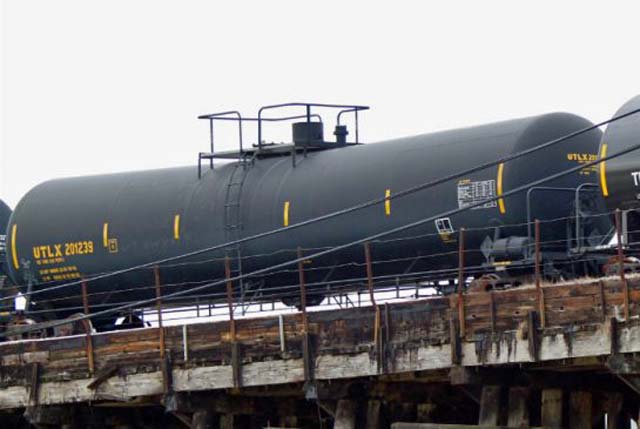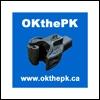

A DOT-111 tank car - Date unknown Roy Luck.
14 October 2013 Lake Megantic Disaster Reveals Urgency of Improving Safety of Rail Cars Chicagoland Illinois USA - As the fires blazed in Lake Megantic, Karen Darch sat horrified in her Illinois house 1,700 kilometres away, thinking the disaster hit too close to home.
Freight trains loaded with flammable materials such as ethanol have increasingly been passing through Darch's hometown of Barrington, and many other suburban Illinois communities known as Chicagoland.
Since 2008, when Canadian National Railway acquired a track that weaves through the region, the number of trains trundling past has increased as much as four-fold in some towns including Barrington, said Darch, the village president.
When the Lake Megantic disaster occurred, it was all too easy to envision a deadly train disaster unfolding nearby, because one already had.
"My first thoughts," said Darch, "were, oh no, not again."
In 2009, a deadly derailment and explosion in Cherry Valley, Illinois, about an hour's drive from Barrington, brought into stark relief the importance of rail safety.
In particular, Darch and other Chicagoland leaders have focused their attention on a much-criticized class of rail car known as the DOT-111.
Making up a significant percentage of both the Canadian and American rail fleet, DOT-111 cars were flagged as problematic beginning in the 1990s due to their tendency to breach in a derailment. Criticism has increased in recent years, as the class of car, which is made by various manufacturers, is more frequently being used to haul dangerous and flammable goods, including crude oil.
In the Cherry Valley derailment, which killed one woman and seriously injured others, DOT-111s were a deemed a contributing factor.
It wasn't a surprise for Darch to learn that DOT-111 cars were in use on the runaway train that sped into Lake Megantic in July.
The probe into the accident is ongoing, and investigators have not revealed details about what role the tank cars may have played in the disaster. Shortly after the 6 Jul 2013 derailment, Ed Burkhardt, chair of Montreal Maine & Atlantic Railway (MMA), the rail carrier whose train derailed in Lake Megantic, told La Presse that he didn't believe a different type of tank car would have made a difference in the tragedy.
Andy Ash, director of the dangerous goods team for the Railway Association of Canada (RAC), said the cars' record suggests there shouldn't be concern.
"You gotta go back to the statistics," Ash said, citing an Association of American Railroads figure that found 99.997 percent of hazardous material carloads travelling by rail arrive without an accident-caused breach.
Ash points out that the North American tank car committee, which sets industry standards, recently created self-imposed rules requiring DOT-111 tank cars ordered after October 2011 to be produced to a higher safety expectations. That includes thicker shells and protective shields on the ends of tanks.
According to the RAC, roughly half of the tank cars used to move crude today were built to those higher standards.
But safety experts in both the U.S. and Canada remain concerned about the tens of thousands of DOT-111 cars manufactured before October 2011. Once produced, the tank cars can have a life span of up to 40 years.
On a mission to make rail transport safer, Darch's Chicagoland rail safety group, known as The Regional Answer to Canadian National, has helped kick-start a U.S. federal law-making process they hope will prompt the retrofitting of older, breach-prone DOT-111s. The first stage in the creation of a new regulation began last month.
The Lake Megantic disaster could provide the much-needed push to get that legislation through, Darch said.
"It really underscored the need to move, and move quickly," she said.
Tougher DOT-111 regulation in the U.S. could, in turn, force regulator Transport Canada to follow suit, say industry experts.
"It may very well be that Barack Obama's Department of Transportation imposes a new rule on movement of oil by rail in Canada," said Keith Stewart, an energy policy expert with Greenpeace Canada.
The crusade against the DOT-111 began for the Chicagoland coalition in June 2009 when a 114-car Canadian National train was passing through Cherry Valley.
As vehicles stopped at the railway crossing, 19 rail cars jumped the tracks, 13 of them breaking open and spewing flammable ethanol fuel that ignited a blaze.
Occupants of the nearby vehicles fled the inferno. One middle-aged woman did not escape. Witnesses told local media she could not outrun the flames.
"She burned to death," said Darch.
Two other people, including the deceased woman's pregnant daughter, were seriously injured, and the baby died. CN agreed to pay US$36.2 million to the family.
Investigators from the National Transportation Safety Board deemed a washed-out track, brought on by heavy rains, was the probable cause of the accident. But in its March 2012 safety report the board bluntly described the role DOT-111s played in the accident, saying the "inadequate design... made the cars subject to damage and catastrophic loss of hazardous materials during the derailment."
In that report, which contained safety recommendations, investigators listed various problems with the tank cars, including that their thin shells and heads can "almost always be expected to breach in derailments that involve pile-ups or multiple car-to-car impacts."
Canada's Transportation Safety Board, too, has for years reported problems with the tank cars, including in a 1997 railway investigation report that criticized the lack of protective housings that would help mitigate damage to the tank's top fittings.
Improvements to the car have been made. Since the Cherry Valley accident, the Association of American Railroads North American Tank Car Committee, a body that sets industry standards, opted to improve the crashworthiness of the newly built DOT-111 cars. Enhancements, including thickening tank shells and putting shields on the ends of tanks, have been made on DOT-111 cars ordered for crude oil and ethanol transport after October 2011.
But safety experts say these measures do nothing to increase the security of DOT-111s tank cars already in American and Canadian fleets. Cost is a major factor stopping the industry from making improvements. Retrofitting older cars with features such as reinforced shells and heads would cost at least US$1 billion, according to the U.S. safety board's 2012 report following the Cherry Valley disaster.
That report also criticized U.S. regulator, the Federal Railroad Administration, for its inaction on phasing out the existing cars, a stance that "ignores the safety risks posed by the current fleet."
"We just thought this was ridiculous," said Darch. "Here was this very explicit report from the safety board who investigates accidents and can make recommendations, but can't do anything at all to change the rules."
In April 2012, the Chicagoland group filed a request to the U.S. Pipeline and Hazardous Materials Safety Administration (PHMSA), an arm of the Department of Transportation, to create a rule forcing rail car owners to retrofit or phase out older DOT-111s.
The group was told there was merit to their request and that the regulation creation process was going to be launched. Since then, there hadn't been much action.
But Darch said Lake Megantic seems to have put a renewed focus on the issue of hazardous materials transportation.
Public hearings into proposed rail safety regulations were held in August. On 6 Sep 2013, PHMSA initiated what's called an "Advance Notice of Proposed Rulemaking", a 60-day feedback period, during which time the public, industry, and other stakeholders are encouraged to weigh in on possible changes to rail safety regulations.
After that, PHMSA will consider the feedback, then possibly create new regulations, a process that could take months or longer. A PHMSA official could not be reached for more information on the process, including an estimated time-line.
Stewart, the Greenpeace energy policy expert, said it could take some time, but if a new regulation is created it would be worth the wait.
"In the U.S., they tend to move slowly, but once the rules take effect, they are enforced," he said.
Darch's group has, in the mean time, partnered with a new Canadian rail safety group, the Cross-border Municipal Coalition for Railway Safety, a group initiated by the Union of Quebec Municipalities in the wake of the July tragedy.
The coalition has written a resolution, to be adopted by North American municipalities, to demand public authorities review and modernize the railway industry.
"The idea was that this crash could have been in any city, in the U.S., or in Canada," said Martine Painchaud, the coalition's director of international relations.
Thirty five cities, towns, and unions representing numerous municipalities have adopted the resolution. Barrington town council and the Chicagoland rail safety group are set to debate adopting it this month.
The international nature of the rail industry means that if the U.S. calls for the retrofitting of DOT-111 cars manufactured before October 2011, it would likely prompt officials here to follow suit.
The importance of harmonized American and Canadian regulations was clear in an August report on safety released by the Senate's committee on energy, the environment, and natural resources.
That report, "Moving Energy Safely," echoed the problems with the DOT-111 car identified by both countries' transportation safety boards, and expressed concern about the fleet of cars built before October 2011.
It recommended Transport Canada review the use of DOT-111 tank cars and consider acelerating the transition to the improved standard, "in co-operation with the United States Department of Transportation."
Senator Grant Mitchell, deputy chair of the Senate committee, said that explicit directive to work with the U.S. was made because otherwise there could be "tremendous problems with commerce."
The U.S. could force Canada to use their rail cars, or else not allow fuel to come into the country, he said.
"I hope that there is an initiative and momentum coming from the States that would encourage us. On the other hand, I hope there's an initiative coming from us that would encourage them," Mitchell said.
Ash, the Railway Association of Canada's dangerous goods director, said a harmonization of regulations between countries benefits both sides of the border. But he said the North American tank car committee, which he sits on, is in the process of reviewing its own, self-enforced safety regulations.
"We're trying to be proactive, we're not waiting for regulations or rules," he said.
For Darch and others working to make DOT-111 cars safer, it doesn't matter who brings about the change as much as when it occurs.
"People are at the mercy of the rail industry," said Darch. "If we're going to be safe out there, we need to address these issues."
Wendy Gillis.



Vancouver Island
British Columbia
Canada |

